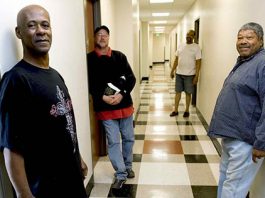
The Bureau of Prisons currently oversees the care of 143,407 federal inmates in the institutions it manages.
….
Source: https://eji.org/news/covid-19s-impact-on-people-in-prison/
People who are incarcerated are at great risk of sickness and death as a result of the Covid-19 pandemic and more must be done to release people who are imprisoned and are not a threat to public safety or are elderly or infirm. The inability to quarantine or practice social distancing, together with overcrowding, imperils the lives of many people incarcerated in jails and prisons.
Nationwide, the known infection rate for Covid-19 in jails and prisons is about 2½ times higher than in the general population. More than 44,000 incarcerated people and staff have coronavirus infections and 462 have died.
Seven of the 10 largest outbreaks in the country have been at correctional facilities, including two Ohio prisons—Marion Correctional Institution, with 2,439 cases, and Pickaway Correctional Institution, with 1,791 cases. Widespread testing at a federal prison in Lompoc, California, has revealed another large cluster of 1,020 cases. Nearly 70% of people incarcerated at Federal Correctional Institution Lompoc tested positive.
The biggest hot spot in the country is at Trousdale Turner Correctional Center, a private prison in Tennessee run by CoreCivic, where 1,384 of 2,444 incarcerated people tested positive for the coronavirus. The state has committed to testing of all state prison inmates and staff after widespread testing at Trousdale and another prison, Bledsoe County Correctional Complex, found large numbers of positive cases.
The virus is spreading rapidly in prisons across the country, and the examples continue to mount. Seventy percent of Texas prisoners tested have the coronavirus. The virus has infected more than 1,600 incarcerated people and prison employees. At least 25 have died. But testing has been limited to only 1,700 people—about 1% of the state’s prison population.
And nearly 60% of the 1,400 men incarcerated at Michigan’s Lakeland Correctional Facility have tested positive for Covid-19—that’s at least 785 positive cases and 14 deaths. Lakeland is like hundreds of other prisons in America in its design and structure and the makeup of its incarcerated population. Located in Coldwater, it houses 1,403 people who have been sentenced to spend years, decades, or the rest of their lives in prison.
Many of these prisoners will die, as will thousands of other incarcerated people in the U.S. because of mass incarceration and our carceral policies. The pandemic has exposed serious problems with American incarceration that need to be addressed.
Overcrowding
At year-end 2018, the prison custody population in 25 states and the federal Bureau of Prisons had a total number of prisoners in custody that met or exceeded their minimum number of beds.
Because prisons have more people incarcerated than they were designed to hold, incarcerated people are crammed into dorms and warehoused in rooms with bunks sometimes three beds high and only inches apart.
Social distancing is not an option under these conditions. And at Lakeland and many other prisons, it’s impossible to quarantine large numbers of infected prisoners. As a result, the risk of infection for imprisoned people and correctional staff is extremely high.
Vulnerable Populations
After decades of extreme sentencing, older adults today make up a larger share of the state prison population than people age 18 to 24. Older people are at a higher risk of serious complications from Covid-19. Older people in prison are more likely to be in poor health and have limited access to quality medical services, which increases the risk of death in a public health crisis.
“Tough on crime” policies including three-strikes laws and truth-in-sentencing schemes have dramatically increased sentences for people convicted of felonies and significantly reduced eligibility for parole. Accordingly, the percentage of people in state prisons who are 55 and older more than tripled between 2000 and 2016—to nearly 150,000 older people incarcerated in state correctional facilities in 2016.
Generally, people in prison—where a lot of time is spent sitting around and food is typically poor quality—tend to be in worse health than those outside prison, The Lancet reports. Lack of access to quality medical care means that older people in prison suffer more often from chronic health conditions like hypertension, asthma, and diabetes that increase the risk of serious complications from the coronavirus.
Violence and Abuse
The Covid-19 crisis has reduced the number of correctional staff, and in many places states are unable to provide adequate security, which leads to more violence and abuse within jails and prisons.
In Alabama, which has the highest rate of prison homicide in the nation, two incarcerated men died violently in two different prisons in less than one week in March, and a third was killed in April. Their murders bring the death toll in Alabama prisons to 10 homicides in the past eight months and 26 in the past two years.
Jails
Jails are filled with people who have not been convicted of a crime,1 many of whom need medical care and social services that jails consistently fail to provide. Even without a public health crisis, too many people in jail are denied adequate medical care.
Cook County Jail in Chicago, one of the nation’s largest jails, reported a rate of coronavirus infection that was higher than almost anywhere else in the country, with more than 1,018 people testing positive so far.






